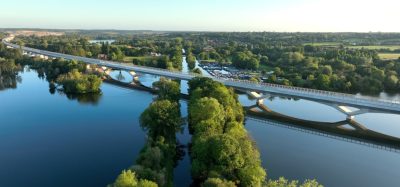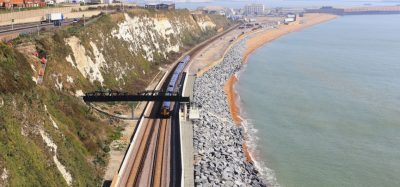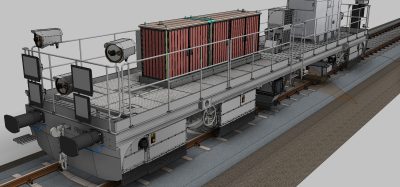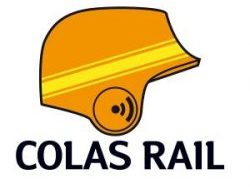An overall view of maintenance
Posted: 23 August 2005 | | No comments yet
The task of Banverket, the Swedish National Rail Administration, to safeguard the state-owned railway infrastructure is performed with the aid of significant maintenance so as to ensure its operations achieve the transport policy goals set out by Sweden’s Government. Maintenance is a link in securing a transport system for the general public and industry throughout Sweden that is both socio-economically effective and sustainable in the long term. Maintenance is a precondition for ensuring that the investments made will have the lifetime and outcomes that have been planned.
The task of Banverket, the Swedish National Rail Administration, to safeguard the state-owned railway infrastructure is performed with the aid of significant maintenance so as to ensure its operations achieve the transport policy goals set out by Sweden’s Government. Maintenance is a link in securing a transport system for the general public and industry throughout Sweden that is both socio-economically effective and sustainable in the long term. Maintenance is a precondition for ensuring that the investments made will have the lifetime and outcomes that have been planned.
The task of Banverket, the Swedish National Rail Administration, to safeguard the state-owned railway infrastructure is performed with the aid of significant maintenance so as to ensure its operations achieve the transport policy goals set out by Sweden’s Government.
Maintenance is a link in securing a transport system for the general public and industry throughout Sweden that is both socio-economically effective and sustainable in the long term. Maintenance is a precondition for ensuring that the investments made will have the lifetime and outcomes that have been planned.
At present, extensive development work is in progress within Banverket aimed at increasing the efficiency of maintenance operations. In order to gain sufficient insight into the individual parts, it is necessary to shed light on how they are inter-linked to form a single entity. This entity is described in Banverket’s overall maintenance strategy.
It is also important that everyone involved in the management and direction of maintenance operations should share a common view of what is to be achieved.
One step in the overall maintenance strategy is to clarify those aspects that are critical if maintenance is to be able to help in achieving Banverket’s goals. Crucial in our approach are the areas for improvement, which in turn means that the strategy is focused on areas in which there is a need for further development.
Parts of the development work
The development work within maintenance activities is conducted jointly on a broad front by Banverket’s administrative organisation. The projects together cover all maintenance operations, both the work flow – the ‘maintenance processes’ – as well as in-depth penetration into the major infrastructure categories. Some of the development projects that are currently in progress are:
- Banverket’s overall maintenance strategy – a common umbrella with goals and guidelines that apply to all development projects
- Track categories – goals for the maintenance broken down from a common overall objective into goals for each track section
- Developed status assessment – the introduction of a common model for assessing the condition of the infrastructure, values for measuring the condition, etc.
- An operational manual for planning and procuring maintenance and for directing and monitoring the implementation of maintenance measures
- Guidelines and procedures for materials supply
- Guidelines for traffic flow orientation
- Maintenance systems
- Common guidelines and procedures for the planning of track engineering works
- Specific infrastructure-oriented strategies including maintenance strategy for overhead contact lines, points and tracks
In the long term, specific infrastructure-oriented strategies will be drawn up for all items of infrastructure on the basis of common goals and guidelines.
Banverket’s overall maintenance strategy
The basic starting point for Banverket’s overall maintenance strategy is the transport policy goals, the needs of Banverket’s customers, Banverket’s vision, and finally – the most central aspect – cost-effectiveness throughout the lifetime of the infrastructure.
The strategy work has commenced by identifying what the maintenance shall lead to.
Banverket’s common vision for maintenance work is formulated as “We conduct cost-effective maintenance operations that result in safety, reliability and comfort for the customer”. Banverket’s vision for the maintenance activities is supported by four overall goals:
- Maintenance operations shall lead to the achievement of established demands for reliability
- Maintenance operations shall lead to the achievement of established demands for comfort
- The maintenance activities shall be a step in ‘securing safety’
- The cost-effectiveness of the maintenance activities shall be constantly improved
Behind each overall goal there are defined values that will ensure the results of the maintenance operations can be measured in a satisfactory way. The difficulty, however, is in isolating the effects of the maintenance activities from the effects of the operative work and from new investments/upgrades of the railway network.
The process of maintaining railway infrastructure starts as early as in the conceptual stages of the work on developing new infrastructure (the term is used here in a wide sense for new facilities, systems, components, etc.) and does not end until the infrastructure has been phased out, decommissioned or perhaps recycled.
In strategy work, Banverket has identified a number of critical success factors that indicate what is necessary in order to make it possible for Banverket to achieve the overall goals for the maintenance. After each critical success factor a specification is given as to which overall goal(s) it supports. They have been subdivided into critical success factors and other success factors in order to steer the development work towards those parts that are most decisive for the achievement of the vision.
Critical success factors
- Guidelines as to which functions – primarily safety, reliability, and comfort – are to be achieved in the short and long terms for different parts of the railway network (1, 2, 3).
- A purpose-oriented maintenance system with access to information on infrastructure models, planned and completed maintenance work, the condition of the infrastructure, functional faults, incidents and accidents, etc. (1, 2, 3, 4).
- Method for assessment and analysis of the condition of the infrastructure and degradation curves (1, 2, 3, 4).
- Method for establishing and measuring the relationship between operational reliability, the condition of the infrastructure and the maintenance work carried out (1, 2, 3, 4).
- Method for measuring the cost-effectiveness of maintenance operations (4).
- Guidelines and procedures for the feedback of knowledge and experience (1, 2, 3, 4).
Other success factors
- Continued competition within the suppliers’ market (4).
- Competence, sizing and use of resources to be adapted to current requirements (4).
- Knowledge and routines for the planning of track engineering works from a socio-economic point of view (1, 4).
- Method for applying a life-cycle perspective for the infrastructure (4).
- Forecasts for work and material requirements (1, 4).
- Guidelines and procedures for materials supply (1, 4).
- Guidelines and procedures for the procurement of maintenance contracts (4).
- Guidelines and procedures for the decommissioning of infrastructure facilities (4).
- Working methods for the development of maintenance activities, the securing of a process for constant improvements (1, 2, 3, 4).
Strategies
Work is in progress as part of the overall strategy on producing sub-strategies for maintenance operations with the life cycle of a facility and the process of maintaining railway infrastructure as basic starting points.
The common guidelines and strategies are to be presented under the following main headings:
- Phase 1 – Development and introduction:
- Standard for the function of the facility
- Long-term demands for the operational reliability of the facility
- Guidelines for procurement, including procedures for the introduction of new facilities and a lifetime economy
- Standard of materials
- Phase 2 – Facility in operation
- Assessment and analysis of the condition of the facilities
- Prioritisation of maintenance measures
- Planning and procurement implementation of maintenance measures
- Control and monitor implementation of maintenance measures
- Follow-up maintenance activities
The results of this work are to be presented at the end of 2005.
Track categories
The system of track categories, or classes, for directing maintenance work has been in existence since 2001 and is now being developed. Greater consideration will be especially given to socio-economic aspects.
The track categories specify the technical condition that each section of track in the railway network should have. The technical condition is measured in terms of train delay hours caused by faults in the infrastructure, functional disruptions, track-bed quality and inspection observations.
The target level is set basically on the basis of the results of previous years for the parameters that describe the technical condition, traffic volume (gross tonnage and number of trains) and the quantity of track metres and sets of points within the respective section of track.
Developed status assessment
Banverket has developed a model aimed at describing in a uniform way the technical condition of different sections of track and facilities. The model will be implemented throughout the entire organisation at the same time as values or parameters will be established for measuring the condition of the different infrastructure categories. In a first stage, this work will be carried out in connection with tracks, overhead contact lines and road protection facilities.
Operational manual for planning and control
Banverket intends to create a common approach for the planning and procurement of maintenance and for the control and monitoring of maintenance work implementation. The process has been identified and determined and work on the production of instructions, checklists and models for the process is in its final stages. The material shall be included as part of Banverket’s common management system.
Guidelines and routines for materials supply
Material accounts for a substantial part of Banverket’s overall expenditure and the supply of material for the railway infrastructure is of great importance for operational reliability and cost-effectiveness. Banverket has set up a unit that will develop materials supply. The work of the unit will be performed by a materials group team whose task includes producing a common standard for the materials to be used on railway infrastructure. The material will, of course, be adapted to those functions (speed, loading gauge, axle load, etc.) that different parts of the track will cover. Other tasks similarly regulated are the development of methods for predicting material consumption, routines for procurement, etc.
Guidelines for traffic flow orientation
It is not practicable to conduct maintenance activities that only take the technical status of the railway infrastructure into consideration. With the aid of track categories and a developed system of engineering works planning, maintenance shall to a large extent be oriented to traffic flows. Track category is determined on the basis of traffic volumes and the planning of track works shall be performed with due consideration to the requirements of the railway undertakings. It shall not be regional boundaries that govern the planning of maintenance – the focus shall instead be on traffic flow.
Maintenance systems The structure for describing how different units in the railway infrastructure are inter-linked is of major strategic importance. Within Banverket, the structure is specified in a standard entitled ‘BVS 811, Banverket’s Facility Structure’. The subdivision into different items of infrastructure comes up again in the IT applications that support the maintenance operations:
- BIS: In the infrastructure register, BIS, all the items of infrastructure, or facilities, are arranged geographically and in accordance with Banverket’s Facility Structure. In BIS, for example, information is collected prior to work on train timetables and before work in connection with inspections.
- BESSY: In the inspection system BESSY, comments are registered per facility on completion of inspection. The data is registered directly during the course of the inspection with the aid of a palm computer.
- Ofelia: Ofelia contains information on all faults in infrastructure that have been registered on a particular railway facility. The faults are sorted on the basis of the structure used in BIS.
- Duvan: Duvan is an analysis tool in which information from, for example, BIS, BESSY, Ofelia and the financial system (Agresso) can be linked together and used for the purpose of further analysis.
Banverket has initiated a preliminary study with the aim of further improving the maintenance system. An assessment has been made to the effect that a more powerful instrument is needed in order to be able to follow more efficiently the status of individual infrastructure facilities and the affects that are attained by different maintenance measures.
Common guidelines and procedures The planning of engineering works has previously been carried out regionally and partly in five different ways. During 2004 and 2005, Banverket has invested intensively in developing a common process for engineering works planning. The purpose of this process is on the one hand to meet the requirements of the new Railway Act but also to improve the work flow from status checking and the planning of measures prior to implemented and completed maintenance measures. The planning of engineering works shall be based on both the need of the facility for maintenance measures and the need of the railway undertakings for continuity in their traffic flows.
Specific infrastructure strategies Maintenance strategy for overhead contact lines
For Banverket, as the owner of contact line installations, it is important to have a well-developed and cost-effective maintenance strategy that guarantees a high level of operational reliability. This requires the planning of inspections (status checks) and maintenance measures in both the short and long terms.
The maintenance is divided up, as shown in Figure 4, and is based on preventive maintenance of the infrastructure consisting of status-based and scheduled maintenance as well as corrective maintenance. The strategy is to minimise the corrective maintenance (current work) and in the preventive maintenance to as far as possible change from scheduled maintenance to status-based maintenance.
The working process prior to the implementation of contact line maintenance shall lead to a decision on measures decided on the basis of rational and verifiable grounds.
The motor in the status-based maintenance, the entirely dominating feature of the strategy for contact line maintenance, is continuously checking by inspecting how the facilities are functioning. A large proportion of the measurements shall be taken mechanically with the aid, for example, of a testing and recording coach that measures the dynamic geometry of the contact line and the contact forces of the pantograph, the thermography of those contact lines that are more than 30 years old for the purpose of detecting hidden faults by means of temperature measurement, direction finding which is used if it is necessary to find faults that are difficult to detect, for example cracked insulators and broken conductor parts as well as intermittent faults, detector installations for monitoring vehicle pantographs, etc. All data on infrastructure that is collected mechanically or manually has to be registered in a purpose-oriented way so that it can be used for status assessment purposes. In this context, use is made of the inspection instrument BESSY in which palm computers make it possible for information to be given in immediate connection with the inspection. But it is not enough to simply collect data and register it in purpose-oriented IT applications. It is also necessary for the analysis activities to work. Therefore, the strategy also includes a well-functioning analysis procedure. It is not until all the pieces of the puzzle are in place – accurate status data on the contact lines, effective IT applications for storage of the status data, a well-functioning analysis procedure – that it becomes possible to rank in order of priority which measures need to be carried out and when in terms of time.
The second leg of the strategy is scheduled maintenance, but this is limited to components that are of decisive importance to the entire catenary system and where there is sound knowledge as to the lifetime of the components. The scheduled maintenance of catenary systems comprises the lubrication of line wheels every third year, the maintenance of section insulators in accordance with the manufacturer’s instructions, the lubrication of bearings on the disconnector units every sixth year, the maintenance of motor control devices in accordance with the manufacturer’s instructions and, in the case of transformers, replacement of the drying agent every year.
Maintenance strategy for tracks
During spring 2005, work started on a strategy for track maintenance that is based on the following parts:
- Load expressed as gross tonnes, with a clear connection to track categories
- Planned lifetime of the track on the basis of accumulated load (traffic age)
- Times and criteria for maintenance measures, for example, a mixture between status-based maintenance and scheduled maintenance. This shall be based on a balance between:
- Costs of maintenance measures
- Costs of wear and tear (decrease in the value of the infrastructure)
- Costs of operational disruptions (shortfalls in comfort, rain disruptions owing to infrastructure faults, etc.)
- Description of the status parameters that are needed in order to be able to take a decision on necessary maintenance measures and how they are to be presented
The maintenance strategy for tracks shall be presented at the beginning of 2006.
Maintenance strategy for points
During autumn 2005, joint work will commence on the maintenance of points. The goal in this context is also that initial results shall be presented at the beginning of 2006.
Conclusion
Banverket’s intensive investment in maintenance operations which is aimed both at covering the breadth of the maintenance issues and at the same time working in depth within different infrastructure categories, shall lead in the first instance to an improved level of cost-effectiveness and operational reliability. At the same time, safety is always the basic design factor for maintenance activities. The entire investment is, of course, focused on achieving the vision of the maintenance operations, i.e. “We (Banverket) conduct cost-effective maintenance operations that result in safety, reliability and comfort for the customer”.
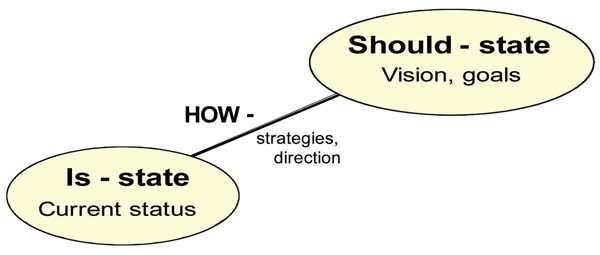

Figure 1: Overall maintenance strategy


Figure 2: A facility's life-cycle


Figure 3: Maintaining railway infrastructure
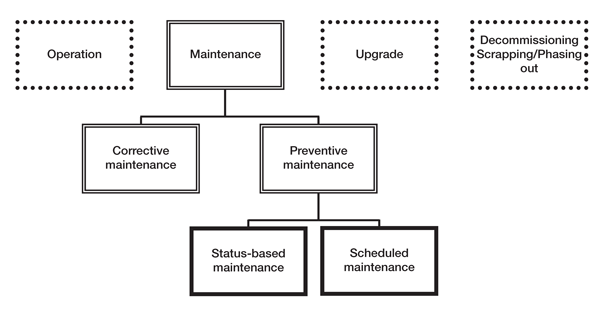

Figure 4: Maintenance Terminology, European Standard, EN 13306
OUT NOW: The Definitive Guide to Rail’s Digital Future
The rail industry is undergoing a digital revolution, and you need to be ready. We have released our latest market report, “Track Insight: Digitalisation.”
This is not just another report; it’s your comprehensive guide to understanding and leveraging the profound technological shifts reshaping our industry. We move beyond the buzzwords to show you the tangible realities of AI, IoT, and advanced data analytics in rail.
Discover how to:
- Optimise operations and maintenance with real-time insights.
- Enhance passenger services through seamless, high-speed connectivity.
- Leverage technologies like LEO satellites to improve safety and efficiency.
Featuring expert analysis from leaders at Nomad Digital, Lucchini RS, Bentley Systems and more, this is a must-read for any rail professional.



